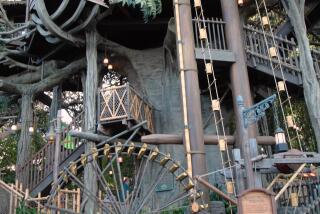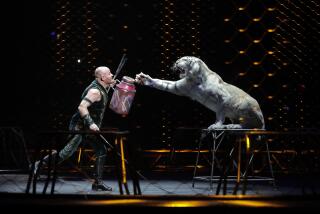âJungleâ Goes Back to Drawing Board : Movies: Disneyâs live-action version of the Kipling tale has the same basic story as the animated hit. But unlike that one, this film has real animals and a balance-of-nature message.
Film remakes themselves are certainly not news; this year alone has seen new versions of âLove Affair,â âMiracle on 34th Streetâ and âLittle Women,â among others.
But Disneyâs forthcoming version of the classic Rudyard Kipling tale âThe Jungle Bookâ is noteworthy not only because itâs the third film version of the tale, but because Disney is also gambling by remaking its own very successful animated version, released in 1967, into a live-action version.
âRudyard Kiplingâs the Jungle Book,â which stars Cary Elwes, Sam Neill and Jason Scott Lee as Mowgli and opens Sunday, is based only loosely on the first âJungle Bookâ (1942), which starred Sabu as Mowgli, the wild boy raised by a wolf pack to respect the ways of nature and distrust man, and the later animated musical version, which featured the voices of Sebastian Cabot and Phil Harris.
But the basic story is the same, and parents everywhere may well wonder, why tell the story again, especially when the musical version remains a family favorite?
Edward S. Feldman (âWitness,â âSave the Tigerâ) says the first version âhad no jungle. It was made in a vacuum--on a sound stage in Burbank during wartime.â Director and screenwriter Stephen Sommers, who had not seen the 1942 version before signing on, agrees.
âI felt we could never outdo the animated version; itâs actually my favorite Disney film,â Sommers said. âBut we could do some things they didnât do. For instance, we could show how the animalsâ names came from the Hindi language. We tried to pay some homage to the previous version by keeping the names the same.â
Indeed, King Louie, Bagheera and Shir Kahn are all back this time out. As Feldman says, âIf you didnât keep the same animals, the audience would laugh you out of the theater.â
There was also the chance to make what Feldman calls âa plea for the animalsâ in this edition. Sommers points to Kiplingâs use of the âlaw of the jungleâ in his stories, and the film carries a low-key message of preservation of the balance of nature, a thread Disney seems to be following lately with âThe Lion Kingâ and next summerâs âPocahontas.â
The Disney decision to revisit its own material started in the early â90s, when co-producer Raju Patel (âBachelor Partyâ) and his father, Sharad, brought Disney a âJungle Bookâ script they had commissioned, and ended in Disneyâs commitment to the $30-million film. Disney brought Sommers aboard as writer and director and called upon the veteran Feldman to produce.
Sommers, who directed 1993âs âThe Return of Huck Finnâ for Disney, wrote a new script that kept a lot of the Kipling story of Mowgliâs encounter with the imperial British but added an adventure element that had been lacking in the animated âJungle Book.â
âThey said it would be a couple of weeks shooting in India,â Feldman says, laughing. âA couple of weeks . . . .â
The location work in Jodhpur, in fact, took about eight weeks. Sommers points to three major challenges to the shoot: âKids, animals and India. We used all real animals; we couldnât use animatronics because we were dealing with animals people are used to seeing--bears, tigers, wolves.â
The crew tried one robot monkey, but âwe all cracked up when we saw it on film; it just wasnât right,â Sommers says. âPeople know how these animals really look and move; itâs not dinosaurs or monsters.â
More to Read
Only good movies
Get the Indie Focus newsletter, Mark Olsen's weekly guide to the world of cinema.
You may occasionally receive promotional content from the Los Angeles Times.










